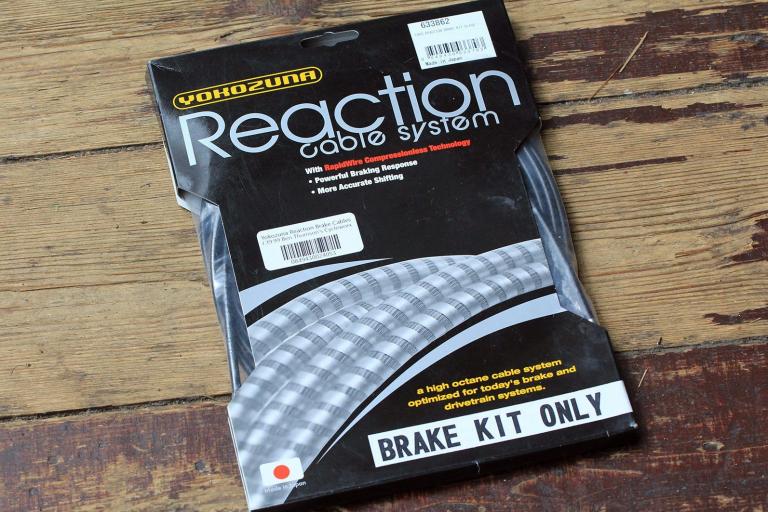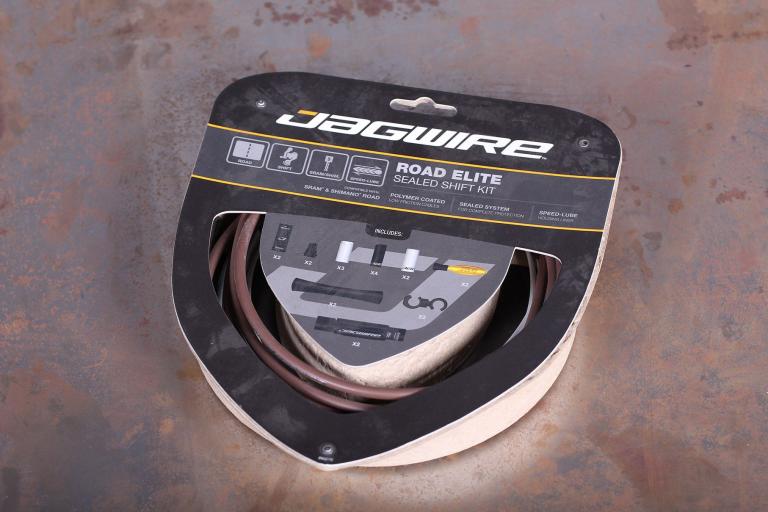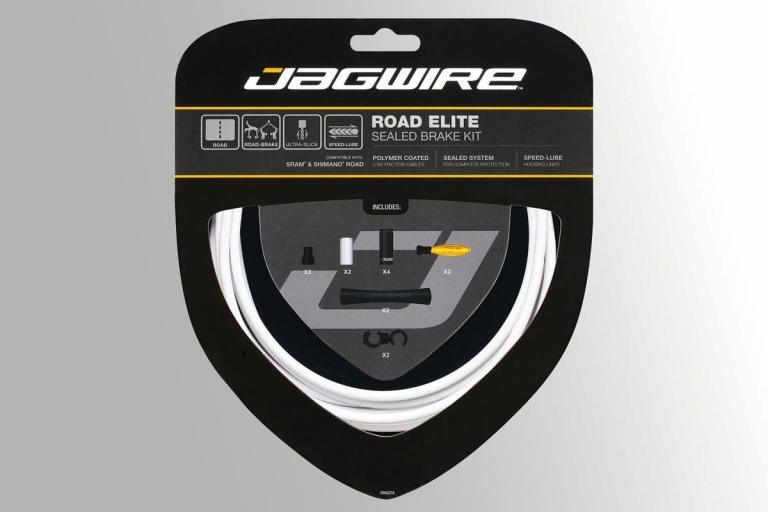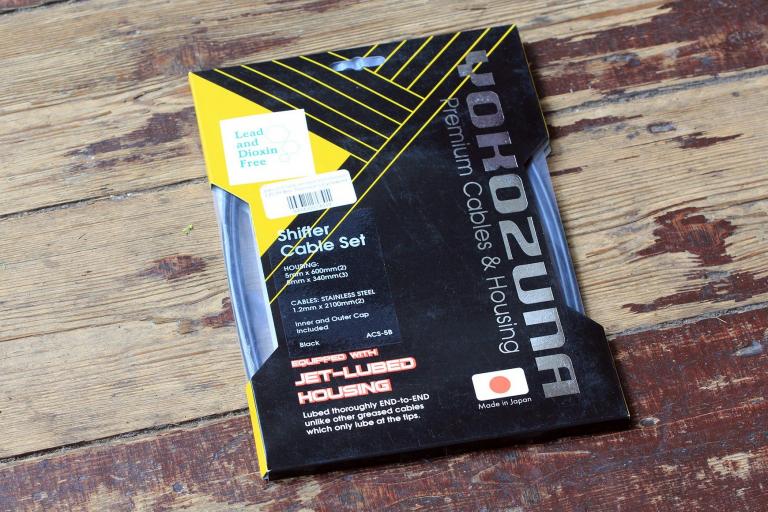- News
- Reviews
- Bikes
- Components
- Bar tape & grips
- Bottom brackets
- Brake & gear cables
- Brake & STI levers
- Brake pads & spares
- Brakes
- Cassettes & freewheels
- Chains
- Chainsets & chainrings
- Derailleurs - front
- Derailleurs - rear
- Forks
- Gear levers & shifters
- Groupsets
- Handlebars & extensions
- Headsets
- Hubs
- Inner tubes
- Pedals
- Quick releases & skewers
- Saddles
- Seatposts
- Stems
- Wheels
- Tyres
- Tubeless valves
- Accessories
- Accessories - misc
- Computer mounts
- Bags
- Bar ends
- Bike bags & cases
- Bottle cages
- Bottles
- Cameras
- Car racks
- Child seats
- Computers
- Glasses
- GPS units
- Helmets
- Lights - front
- Lights - rear
- Lights - sets
- Locks
- Mirrors
- Mudguards
- Racks
- Pumps & CO2 inflators
- Puncture kits
- Reflectives
- Smart watches
- Stands and racks
- Trailers
- Clothing
- Health, fitness and nutrition
- Tools and workshop
- Miscellaneous
- Buyers Guides
- Features
- Forum
- Recommends
- Podcast
review
 Nokon Slimline cable set
Nokon Slimline cable set£69.99
VERDICT:
Undeniably lightweight and super refined cables but only justifiable on the most expensive bikes
Weight:
0g
Contact:
www.windwave.co.uk
At road.cc every product is thoroughly tested for as long as it takes to get a proper insight into how well it works. Our reviewers are experienced cyclists that we trust to be objective. While we strive to ensure that opinions expressed are backed up by facts, reviews are by their nature an informed opinion, not a definitive verdict. We don't intentionally try to break anything (except locks) but we do try to look for weak points in any design. The overall score is not just an average of the other scores: it reflects both a product's function and value – with value determined by how a product compares with items of similar spec, quality, and price.
What the road.cc scores meanGood scores are more common than bad, because fortunately good products are more common than bad.
- Exceptional
- Excellent
- Very Good
- Good
- Quite good
- Average
- Not so good
- Poor
- Bad
- Appalling
There's not getting away from it, Nokon slimline cables are expensive in relation to top-flight weather sealed Bowden type cables, they're even more expensive than standard width Nokons,and installation is very time consuming too. On the flip side, performance is superb and the design's malleable characteristics come into their own on bikes with torturous cable runs and or/unusual cockpit configurations (e.g. long but relatively high stem and narrow bars) plus they are claimed to last much longer than standard cables which goes some way to jutifying the price. However, rubberised cable cuffs or good quality electrical tape are essential to prevent the aluminium housing chafing pretty frame finishes.
These Slimline versions of Nokon's classic design are, say Nokon, 58 per cent lighter than traditional types, (Nokon claim their standard width cables are 30 per cent lighter). So these are very much aimed at the weight weenie wanting to put the finishing touch to a bling bike.
Open the packaging and you're presented with a beautiful anodised outer, Teflon inner sleeve and common or garden stainless inners. The housing is actually fashioned from segments that slot together like a beaded necklace, eliminating the need for cutting and theoretically mistakes. Creative types can also mix and match, adding other colours for the last word in customisation. Set to the correct tolerances, these segments provide stability for the entire system.
Before fitting take time to study and become familiar with the component parts and how they relate to each other. Offer it up to the bike a few times before snipping the Teflon inner sleeve but until then, because the outer can be added or subtracted at will, there's no risk of permanent or costly errors. Closer inspection suggested, other than the precision cut housing, there's little separating sleeve and inner wire from the very best traditional types and in the interests of thorough, investigative testing, I wired the Nokon to front and rear mechs and headed for the muddiest trails and wettest coastal roads I could find.
Credit where due, they've been fit and forget, marginally friskier up and down the block under load too. Despite my initial reservations, there's been no infuriating cable chatter over rougher roads and trails even forgoing nylon cable-cuffs. Swapping the OEM inners with a stainless Shimano made no discernable impression-other than needing a quick tweak to counteract some minor cable stretch on the first outing, leading me to conclude, the outers are key to the concept's success. While undeniably slick, I could only justify the considerable expense on top-flight, finest groupset money's no object steeds -which, again to be fair, is really what they are intended for.
Verdict
Undeniably lightweight and super refined cables but only justifiable on the most expensive bikes.
road.cc test report
Make and model: Nokon Slimline cable set
Size tested: Red
Tell us what the product is for, and who it's aimed at. What do the manufacturers say about it? How does that compare to your own feelings about it?
The website proudly asserts "the future of bowden cables has arrived". Tested in the Tour de France, the slimline are clearly aimed at a competitive audience wanting the last word in low-weight, high performance systems. Credit where due, they've acheived all this but at a price.
Tell us some more about the technical aspects of the product?
Lightweight kit for derailleur
30% lighter than standard
Includes 2 x stainless gear cables
teflon liner and fittings included
Housing 1.8m
Rate the product for quality of construction:
8/10
Rate the product for performance:
8/10
Rate the product for durability:
7/10
Can be rebuilt, as removed fom replaced.
Rate the product for weight, if applicable:
8/10
Rate the product for comfort, if applicable:
8/10
Rate the product for value:
5/10
Initial purchase cost is very hard to justify, despite the levels of performance. Although if they last much longer than normal cables it might start to become less eye-watering
Tell us how the product performed overall when used for its designed purpose
There's no doubting the performance is sweet, slick and better than any system I've used to date. The design has distinct advantages for riders of unsual dimensions-say running long, higher rise stems and relatively narrow bars. Similarly, flexibility greatly improves shifting on machines with torturous cable runs. Used extensively through wet, muddy conditions, shifting has been impeccable without recourse to adjustment or lubrication on a mix and match Shimano drivetrain.
Tell us what you particularly liked about the product
Bling, low weight and undeniably crisp shifting.
Tell us what you particularly disliked about the product
Prohibitive cost.
Did you enjoy using the product? Yes
Would you consider buying the product? Possibly
Would you recommend the product to a friend? Only for top flight builds with unusual configurations/tight cable runs
Anything further to say about the product in conclusion?
Performance and weight are undeniably good but I have to balance this against the cost, hence the lower overall rating.
About the tester
Age: 37 Height: 1m 81 Weight: 70 kilos
I usually ride: Rough Stuff Tourer Based around 4130 Univega mtb Frameset My best bike is: 1955 Holdsworth Road Path and several others including cross & traditional road
I've been riding for: Over 20 years I ride: Most days I would class myself as: Experienced
I regularly do the following types of riding: cyclo cross, commuting, touring, fixed/singlespeed, mtb,
Shaun Audane is a freelance writer/product tester with over twenty-eight years riding experience, the last twelve (120,000 miles) spent putting bikes and kit through their paces for a variety of publications. Previous generations of his family worked at manufacturing's sharp end, thus Shaun can weld, has a sound understanding of frame building practice and a preference for steel or titanium framesets.
Citing Richard Ballantine and an Au pair as his earliest cycling influences, he is presently writing a cycling book with particular focus upon women, families and disabled audiences (Having been a registered care manager and coached children at Herne Hill Velodrome in earlier careers)
Latest Comments
- whosatthewheel 1 hour 37 min ago
Except, the earth isn't flat. It's a cube.
- David9694 3 hours 20 min ago
Black ice or avoiding a cyclist
- Spangly Shiny 3 hours 30 min ago
Ahem, that would actually be two through lanes for the city traffic and two lanes that filter right onto Owlerton Green. This is a major junction...
- chrisonabike 3 hours 46 min ago
Now I'm very afraid. If they're falling back on "but all drivers are trained and we have road laws" as a safety measure all bets are off. As far...
- don simon fbpe 3 hours 55 min ago
They'll go batshit when they find out what TNT Sports have done in U.K.
- Rendel Harris 4 hours 3 min ago
Sorry, I think you can only see this on Facebook, but absolutely brilliant: guy in a Range Rover has his vehicle seized for no insurance, his wife...
- Spangly Shiny 4 hours 40 min ago
So which is the free one then? All the ones I can see in this list will cost.
- don simon fbpe 4 hours 48 min ago
Nice though that Ribble is, it's not a pro-team bike, is it? Got to love a bit of 90s Campagnolo, shame it's only a 50t, but I guess those Chiltern...
- chrisonabike 6 hours 15 min ago
Agree, but again it's how to start to break the vicious circle?...
- chrisonabike 6 hours 26 min ago
I'm either amazed that they can get through with (presumably) a full sized waste truck, or amazed that she could not. Although as you say the bin...




Add new comment
2 comments
Weightwise, the cable outers may be a little lighter.
However I note that the Nokon still uses steel inner cables. On a two brake plus two gear cable setup the steel inners weigh in at approx 70 grams. Aluminium alloy or kevlar cables weigh about 60% less, but are unsuitable because they are much more elastic than steel with its modulus of 200 GPa. Whereas Kevlar and alloy is at approx 70 GPa.
There is another material though with a modulus better than steel at 240 GPA and weighing 80% less at approx 15 grams for a similar 4 cable setup.
Carbon fibre. 24K strands, braided into a yarn of about the same diameter as a steel inner cable with a breaking strain much greater than steel seems the obvious way to go for weight watchers. But I guess that's just the engineer in me talking.
Now that's a product I'd buy.
When I bought Nokon cables, I didn't notice the price or the weight. I just knew they were a lovely red.
PS They seem to be on the Windwave site for £89.95.
PPS I think I've had enough of "cockpit" for a while.